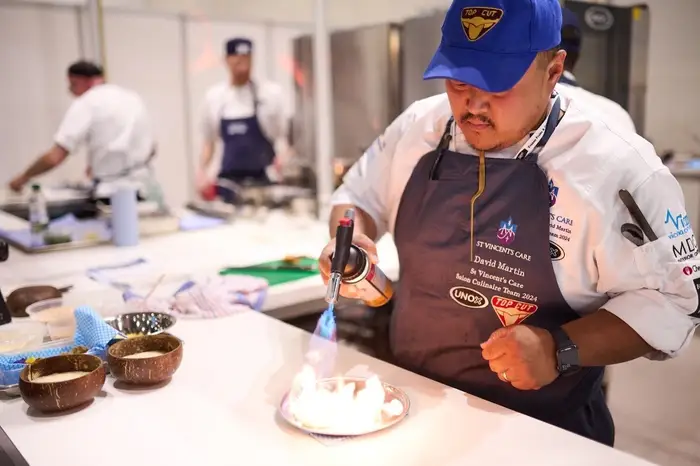Meet the 2 Australian chefs who walked away from top restaurants to serve up premium meals in nursing homes

Harry Shen (pictured) and David Martin are on a mission to change nursing home food.
David Martin can still recall the conversation that changed his career path.
He was 25 and had spent the past decade working in the restaurant and fine dining scene. The hours were brutal — up to 16 hours a day — and he was on the verge of burnout.
His parents brought up the idea of working in a nursing home. They had a cousin who worked in that industry and suggested he try it.
“I told them, ‘Why would I want to go to aged care? That’s where people retire. My skills will go to waste,'” Martin recalled. Still, with an open mind, he decided to give it a shot.
He hasn’t looked back since. Martin, now 35, is an executive chef manager at St Vincent’s Care, a nursing home facility in Australia.

David Martin at the International Salon Culinaire in London.
By his side is Harry Shen, 39, a senior head chef who also left the restaurant scene to try something different. They share the same vision: to raise the standard of food in aged healthcare.
Apart from working under top chefs, including Donovan Cooke, Shen had also picked up shifts at Australian nursing homes in the past. It was during that time that he noticed frozen food was often the norm.
So when he saw a job posting from St Vincent’s for a chef to elevate nursing home food, it stood out.
“This is something I also wanted to do. To change things,” he told B-17.
A premium offering
With Shen on board, Martin and his team worked during the pandemic to reinvent meal plans at one of St Vincent’s healthcare centers in Kew, a suburb of Melbourne. The facility doubles as an aged care home and a hospital.
It’s a more premium nursing home option. According to St Vincent’s Care’s website, a stay at a standard room in the facility costs 171 Australian dollars a night, or around $111 — almost double the basic daily fee for nursing homes in Australia, which is AU$63.57. The room has an ensuite toilet, and residents can access a café, cinema, and hairdressing salon within the facility.

The menu at St Vincent’s Care includes seared steak.
A typical meal plan at St Vincent’s is as follows: In the morning, residents are offered a continental breakfast and a tea cake of the day. For lunch, they have a main with a selected sauce, a starch, and two vegetables.
They end the meal with a sweet — warmed apple coconut strudels on some days and a green tea cheesecake on others — then round the day up with an afternoon tea snack and a generous dinner selection.
“We want to break the stereotype that aged care food is just a lump of food on a plate,” Shen said.
Cooking for older residents does come with certain considerations. In particular, the chefs have to look out for residents who have dysphagia, a geriatric syndrome that affects swallowing. According to the Mayo Clinic, 10% to 33% of older adults have dysphagia and can face malnutrition as a result.
As such, the chefs provide a range of options for residents with different needs so that everyone — even those who struggle to swallow — can enjoy a hearty meal.
Nursing home food on the world stage
Martin and Shen wanted to show the world that nursing home food can — and should — be just as good as restaurant food.
In 2023, they decided to compete in culinary competitions together. After placing in several local competitions, they were approached to apply for the International Salon Culinaire, one of the world’s top competitions for chefs. Previous winners of the competition include Gordon Ramsey and Michael Deane, a Michelin-star chef.
In March this year, the duo competed alongside top chefs worldwide over the three-day competition in London. Their dishes included coconut rice pudding with crème brûlée and seafood paella — food they can serve at a nursing home.

The chefs whipped up an award-winning meal at the International Salon Culinaire.
They emerged with two silver medals. But more than the accolades, they hoped that people would focus on the message they were trying to send.
The chefs are well aware that not all nursing homes have the same luxuries of staffing and budgets to prepare premium meals. Still, it’s about setting a standard, they said.
“We want to make this industry better for now and into the future for our parents and grandparents to be respected in,” Martin said.
“The main thing is the frame of mind. The chef can be creative, whether it’s adding a bit more garnish for presentation or baking things in-house rather than buying,” he continued.
A graying world
Shen and Martin’s efforts come as nations worldwide are graying rapidly. In October, the World Health Organization called for an urgent transformation of care and support systems for older people. They projected that 1 in 6 people will be 60 or older by 2030. By 2050, this number will double to 2.1 billion.
In the US, the aging of the baby boomer generation means that the number of Americans ages 65 and older requiring nursing home care could increase by 75% by 2030, a recent report by the Population Reference Bureau found.
That’s where the importance of food comes in.
Dr. Andrea Maier, a professor of medicine at the National University of Singapore’s Centre of Healthy Longevity, told B-17 that raising food quality is especially important in nursing homes, where people are often at the final stages of their lives and need nutrition.
“If they don’t have an appetite, they’re losing muscle mass, and their health is deteriorating. So food needs to be fun.” When food is fresh and well-plated, it gives residents motivation to eat, she added. “It’s a double positive.”
Then there are the emotional impacts of having a good meal.
“When you’re in a care home, life is relatively unrushed. Dining is one thing that I think people look forward to other than engagement activities,” said Wee Shiou Liang, an associate professor of Gerontology at the Singapore University of Social Sciences.
“So, that experience is even more important.”

Martin and Shen won two silvers at the International Salon Culinaire.
Martin and Shen now collaborate as co-creative directors on menus in St Vincent’s homes across New South Wales and Victoria. They also manage and mentor chefs in the region.
Neither chef intends to return to the restaurant scene. Seeing their impact on their residents has moved them to stay.
Working in end-of-life care, Martin said each meal, pastry, or salad could be the last dish their residents eat.
“And that’s big to me because if you can give comfort to someone when they’re in serious pain, that is a present to them,” he said.
“They don’t need to remember your name. They don’t need to remember the dish. But if at that moment they realize they were at ease and were comforted by you — that’s the heart of it.”






